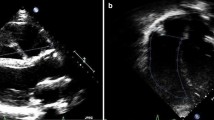Abstract
Right ventricular dilation is a common complication after tetralogy of Fallot (TOF) repair. Traditional echocardiographic assessments are imprecise due to the RV’s location and complex geometry. We propose a novel echocardiographic measurement: RV apical flattening (RVAF) as a screening tool to help identify subjects with severe RV dilation. Patients with repaired TOF who had both echocardiograms and CMR’s within 6-month interval at our institution were included in the study. The RVAF was measured in the four-chamber echocardiographic view as the minor length of RV cavity at the level of RV apical endocardium. Subjects were divided into two groups (group I: RVEDVi ≥ 150 ml/m2 and group II; RVEDVi < 150 ml/m2). Echocardiogram and CMR data were compared between groups. A total of 75 subjects were included in the study. Mean age was 12.8 ± 3.6 years. Group I had 36 subjects, and group II had 39 subjects. The mean RVAF was significantly higher in group I (2.7 ± 0.5 cm) compared with group II (1.7 ± 0.4 cm; p < 0.001). There was significant correlation between RVAF and RVEDVi (r = 0.81; p < 0.001). By ROC analysis, an RVAF cutoff value of 2.0 cm had 94 % sensitivity and 77 % specificity in identifying severe RV dilation (area under the curve 0.95). RVAF is a simple and effective echocardiographic screening tool to help identify severe RV dilation. In conjunction with other 2D echocardiographic parameters, this technique would help further refine echocardiography-guided patient selection for timing of CMR and pulmonary valve replacement.




Similar content being viewed by others
References
Bouzas B, Kilner PJ, Gatzoulis MA (2005) Pulmonary regurgitation: not a benign lesion. Eur Heart J 26(5):433–439
Buddhe S, Shah A, Lai WW (2015) Progression of right ventricular dilation in repaired tetralogy of Fallot. J Magn Reson Imaging 41(3):730–737
Ferraz Cavalcanti PE, Sa MP, Santos CA, Esmeraldo IM, de Escobar RR, de Menezes AM et al (2013) Pulmonary valve replacement after operative repair of tetralogy of Fallot: meta-analysis and meta-regression of 3,118 patients from 48 studies. J Am Coll Cardiol 62(23):2227–2243
Gatzoulis MA, Balaji S, Webber SA, Siu SC, Hokanson JS, Poile C et al (2000) Risk factors for arrhythmia and sudden cardiac death late after repair of tetralogy of Fallot: a multicentre study. Lancet 356(9234):975–981
Geva T (2011) Repaired tetralogy of Fallot: the roles of cardiovascular magnetic resonance in evaluating pathophysiology and for pulmonary valve replacement decision support. J Cardiovasc Magn Reson 13:9
Gregg D, Foster E (2007) Pulmonary insufficiency is the nexus of late complications in tetralogy of Fallot. Curr Cardiol Rep 9(4):315–322
Kim H, Sung SC, Kim SH, Chang YH, Lee HD, Park JA et al (2013) Early and late outcomes of total repair of tetralogy of Fallot: risk factors for late right ventricular dilatation. Interact Cardiovasc Thorac Surg 17(6):956–962
Kjaergaard J, Petersen CL, Kjaer A, Schaadt BK, Oh JK, Hassager C (2006) Evaluation of right ventricular volume and function by 2D and 3D echocardiography compared to MRI. Eur J Echocardiogr 7(6):430–438
Lai WW, Gauvreau K, Rivera ES, Saleeb S, Powell AJ, Geva T (2008) Accuracy of guideline recommendations for two-dimensional quantification of the right ventricle by echocardiography. Int J Cardiovasc Imaging 24(7):691–698
Lang RM, Bierig M, Devereux RB, Flachskampf FA, Foster E, Pellikka PA et al (2005) Recommendations for chamber quantification: a report from the American Society of Echocardiography’s Guidelines and Standards Committee and the Chamber Quantification Writing Group, developed in conjunction with the European Association of Echocardiography, a branch of the European Society of Cardiology. J Am Soc Echocardiogr 18(12):1440–1463
Oosterhof T, van Straten A, Vliegen HW, Meijboom FJ, van Dijk AP, Spijkerboer AM et al (2007) Preoperative thresholds for pulmonary valve replacement in patients with corrected tetralogy of Fallot using cardiovascular magnetic resonance. Circulation 116(5):545–551
Puchalski MD, Williams RV, Askovich B, Minich LL, Mart C, Tani LY (2007) Assessment of right ventricular size and function: echo versus magnetic resonance imaging. Congenit Heart Dis 2(1):27–31
Punn R, Behzadian F, Tacy TA (2010) Annular tilt as a screening test for right ventricular enlargement in patients with tetralogy of Fallot. J Am Soc Echocardiogr 23(12):1297–1302
Therrien J, Provost Y, Merchant N, Williams W, Colman J, Webb G (2005) Optimal timing for pulmonary valve replacement in adults after tetralogy of Fallot repair. Am J Cardiol 95(6):779–782
van der Zwaan HB, Geleijnse ML, McGhie JS, Boersma E, Helbing WA, Meijboom FJ et al (2011) Right ventricular quantification in clinical practice: two-dimensional vs. three-dimensional echocardiography compared with cardiac magnetic resonance imaging. Eur J Echocardiogr 12(9):656–664
Author Contributions
Sujatha Buddhe: Concept/design, Data analysis/interpretation, Drafting article; Approval of article, Mark Ferguson: Concept/design, Critical revision of article; Approval of article, Bhawna Arya: Data analysis/interpretation; Drafting article; Approval of article, Brian Soriano: Concept/design, Critical revision of article, Approval of article.
Author information
Authors and Affiliations
Corresponding author
Ethics declarations
Conflict of interest
None.
Rights and permissions
About this article
Cite this article
Buddhe, S., Ferguson, M., Arya, B. et al. Right Ventricular Apical Flattening as an Echocardiographic Screening Tool for Right Ventricular Enlargement. Pediatr Cardiol 37, 568–574 (2016). https://doi.org/10.1007/s00246-015-1316-0
Received:
Accepted:
Published:
Issue Date:
DOI: https://doi.org/10.1007/s00246-015-1316-0




